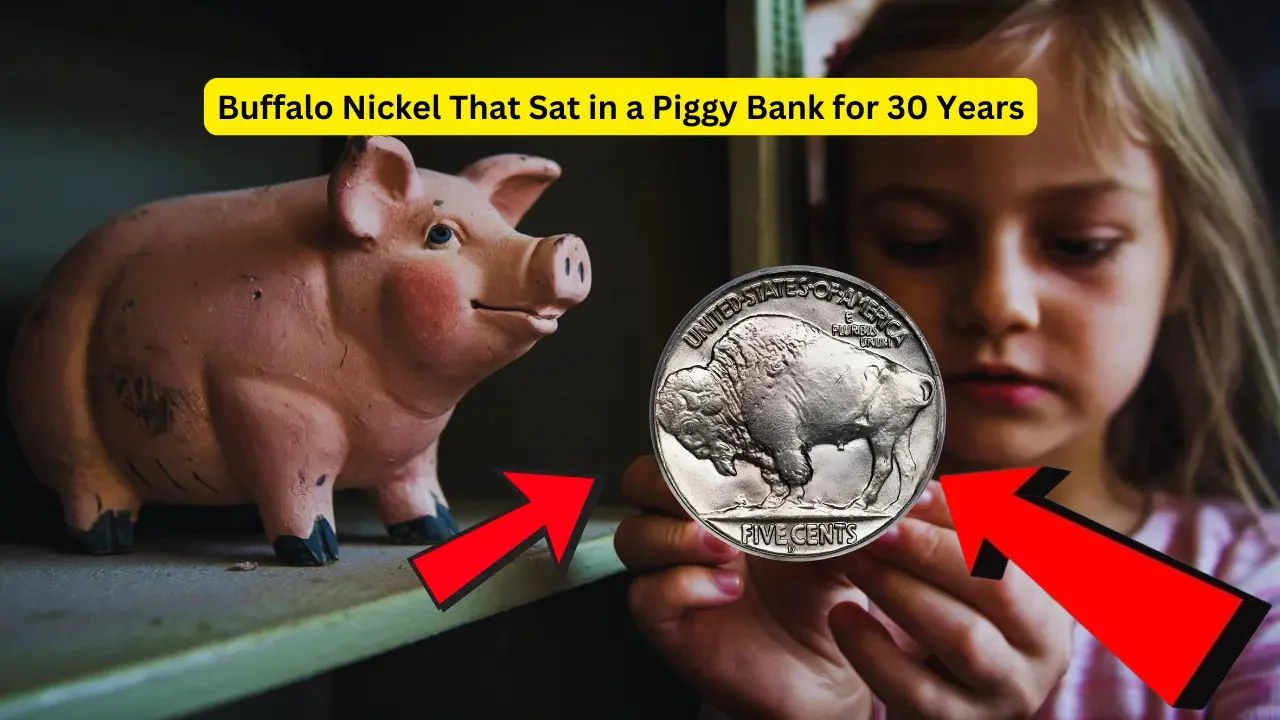The Buffalo Nickel : In the quiet corner of a dusty attic, inside a faded pink ceramic piggy bank, lay a small fortune disguised as a common coin. For three decades, no one gave it a second glance—until one day, curiosity uncovered what would become one of the most exciting discoveries in modern coin collecting: a rare Buffalo Nickel, forgotten for 30 years.
A Coin from America’s Frontier Spirit
The Buffalo Nickel, officially known as the Indian Head Nickel, was minted from 1913 to 1938 and is considered one of the most iconic and beautifully designed coins in U.S. history. Its front features the composite profile of three Native American chiefs, while the reverse displays a majestic American bison—commonly referred to as a buffalo—standing atop a mound.
Though tens of millions were produced, only a few rare dates and minting errors have achieved legendary status among collectors. One such coin would sit hidden for 30 years before making its dramatic return to the spotlight.
A Long-Awaited Discovery
The discovery was made by a homeowner in Ohio during a spring cleaning project in early 2025. Sorting through boxes of childhood keepsakes, the homeowner opened a vintage piggy bank and began rolling coins to deposit at the bank. Among the pile of pennies and nickels was an unusually worn yet striking Buffalo Nickel.
Noticing the faint details, especially the missing date—a common issue with worn Buffalo Nickels—the finder almost tossed it aside as junk. But a gut feeling said otherwise. They posted a photo in an online coin forum, and that single post launched a whirlwind of interest from experts and enthusiasts alike.
What Made It So Valuable?
Upon closer inspection and professional grading, the coin was identified as a 1916 doubled die obverse Buffalo Nickel—an extremely rare and valuable variety. In this error, the date and the words “LIBERTY” and “IN GOD WE TRUST” appear slightly doubled due to a misaligned die during minting.
Only a few dozen authentic 1916 doubled die nickels are known to exist, and this particular one, despite some wear, was in surprisingly good condition. Experts estimated its auction value to be between $80,000 and $110,000.
Why It Matters
This incredible story underscores the idea that valuable coins aren’t always locked away in museums or high-end collections—they can be hiding in plain sight. Piggy banks, dresser drawers, coin jars, and even old lunchboxes can become unexpected treasure chests.
The Buffalo Nickel found in Ohio wasn’t in a display case—it had been mixed in with pocket change, rattling around with other coins, collecting dust for decades. Its value wasn’t just in its age or rarity, but in the mistake that made it stand out: a minting error that transformed it from ordinary to extraordinary.
How to Check Your Own Change
Inspired by this find? Here’s what to look for in Buffalo Nickels:
-
Dates to Watch: 1913 (Type 1 and Type 2), 1916 doubled die, 1918/7-D overdate, 1937-D “Three-Legged” Buffalo
-
Mint Marks: Found below the “Five Cents” on the reverse; rare mints include “D” (Denver) and “S” (San Francisco)
-
Clarity of Design: Full horn on the buffalo and leg detail adds value
-
Errors & Oddities: Doubled dies, repunched mint marks, and overdates are especially valuable
If you find one with a date and mint mark that matches a key rarity—or any unusual design—have it evaluated by a professional grading company.
Final Thoughts
The tale of the Buffalo Nickel that sat quietly in a piggy bank for 30 years reminds us that sometimes, history hides in the most ordinary places. Whether you’re a lifelong coin collector or someone who hasn’t looked at change closely in years, it might be worth revisiting that old jar on the shelf or the coins handed back at the grocery store.
You never know when you’ll uncover a piece of America’s past—worth far more than its face value.
FAQs: The Rare Buffalo Nickel Found After 30 Years
Q1: What is a Buffalo Nickel?
A: The Buffalo Nickel, also known as the Indian Head Nickel, is a five-cent coin minted by the U.S. Mint from 1913 to 1938. It features a Native American on the front (obverse) and an American bison (buffalo) on the back (reverse). It is one of the most iconic and collectible U.S. coins.
Q2: Why was the Buffalo Nickel in the article so valuable?
A: The coin discovered in the piggy bank was a 1916 doubled die obverse Buffalo Nickel — a rare minting error where the date and inscriptions appear slightly doubled due to die misalignment. These coins are extremely scarce and can be worth tens of thousands of dollars, depending on condition.
Q3: How can I tell if I have a 1916 doubled die Buffalo Nickel?
A: Look closely at the date (1916) and the words “LIBERTY” and “IN GOD WE TRUST” on the front of the coin. If they appear doubled or shadowed, you may have a rare variety. A magnifying glass or coin loupe can help. For confirmation, professional grading is recommended.
Q4: Are all Buffalo Nickels valuable?
A: Not all are highly valuable, but key dates, mint errors, and well-preserved specimens can be worth significantly more than face value. Some of the most valuable types include:
-
1913-S Type 2
-
1916 Doubled Die Obverse
-
1918/7-D Overdate
-
1937-D Three-Legged Buffalo
